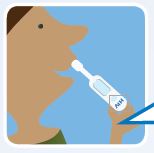The number of people infected with HIV each year has declined, however, new diagnoses among certain groups have remained stable or increased.[1] While public health agencies such as the Centers for Disease Control and Prevention recommend that people at risk for HIV should be tested at least yearly, the number of people testing for HIV may have declined in recent years.[2]
CDUHR-affiliated investigator Ian David Aronson has developed and tested interventions to increase HIV testing among patients who originally declined a test in busy emergency department (ED) settings, using tablet computers to screen patients for sexual and substance use risks. The interventions also provide education in an effort to motivate patients to test. A related study piloted an extended tablet-based intervention to include follow-up text messages to increase preventive behaviors among high-risk patients who test HIV negative.

- The average time spent during the entire screening and intervention process was less than 16 minutes (8.5 minutes among patients aged 18-24)
- Participants reported that the intervention was easy to understand, easy to use, and useful
- Knowledge scores increased significantly through the course of the intervention, based on pre- and post-test questions
- Extensive drug- and sexual-risks were reported during screening



- To provide prevention messages and reminders that repeated testing is important.
- Over 2/3 of young patients who screened “high risk” consented to receive follow-up text messages providing HIV prevention and testing information
- Over half of the participants who received text messages actively responded to them 8 weeks following the initial intervention
These studies support the use of tablet-based interventions to increase HIV testing among hard to reach patients in ED settings. In addition, text messaging may be useful in maintaining ongoing contact with high-risk youth, and extending the benefits of an intervention beyond clinical settings. Increased use of technology can enhance HIV prevention efforts, and potentially increase re-test rates as well.
- Centers for Disease Control and Prevention (2016). Trends in U.S. HIV Diagnoses, 2005-2014. Fact Sheet: https://www.cdc.gov/nchhstp/newsroom/docs/factsheets/hiv-data-trends-fact-sheet-508.pdf
- Centers for Disease Control and Prevention (2016) CDC-Funded HIV Testing: United, States, Puerto Rico and the U.S. Virgin Islands, 2014. http://www.cdc.gov/hiv/pdf/library/reports/cdc-hiv-funded-testing-us-puerto-rico-2014.pdf
Aronson ID, Cleland CM, Perlman DC, Rajan S, Sun W, Bania TC (2016).
Feasibility of a computer-based intervention addressing barriers to HIV testing among young patients who decline tests at triage
Journal of Health Communication [Epub 2016 Aug 11]. doi: 10.1080/10810730.2016.1204382.
Aronson ID, Cleland CM, Perlman DC, Rajan S, Sun W, Ferraris C, Mayer J, Ferris DC, Bania TC (2016).
Mobile screeening to identify and follow-up with high risk, HIV negative youth
Journal of Mobile Technology in Medicine, 5 (1), 9-18. doi: 10.7309/jmtm.5.1.3. PMCID: PMC4838398. Download PDF.
Aronson ID, Marsch LA, Rajan S, Koken J, Bania TC (2015).
Computer-based video to increase HIV testing among emergency department patients who decline
AIDS and Behavior, 19 (3), 516-522. doi: 10.1007/s10461-014-0853-5. PMCID: PMC4308570. Download PDF.
For further information, contact Ian Aronson: aronson@ndri.org.
This work was supported by the National Institute on Drug Abuse (R03DA031603 & R34DA037129, PI: Aronson; P30DA011041, PI: Deren & Hagan)
